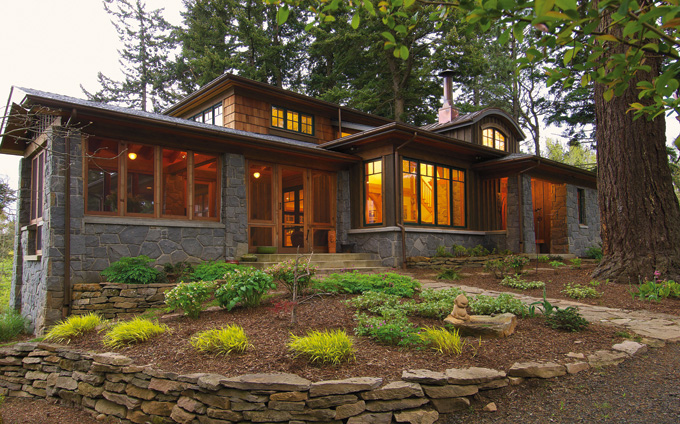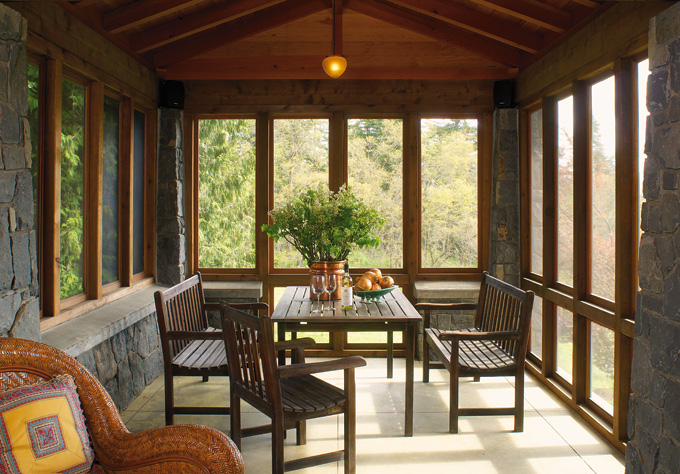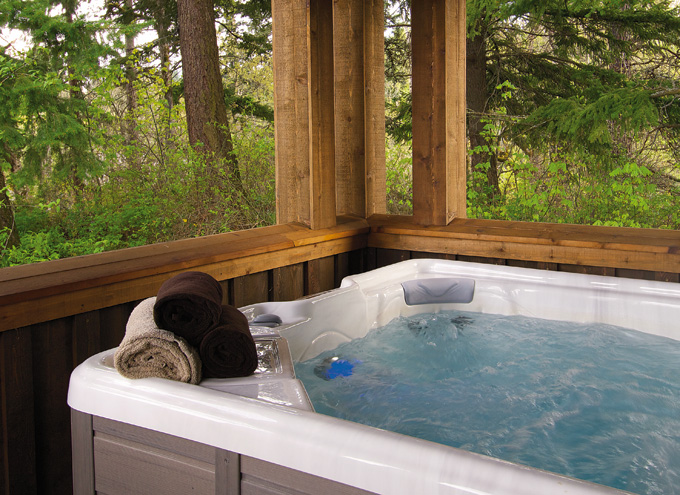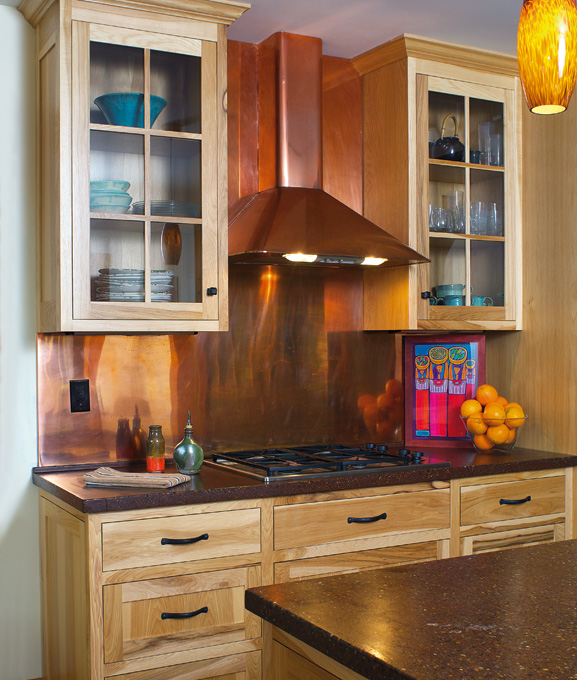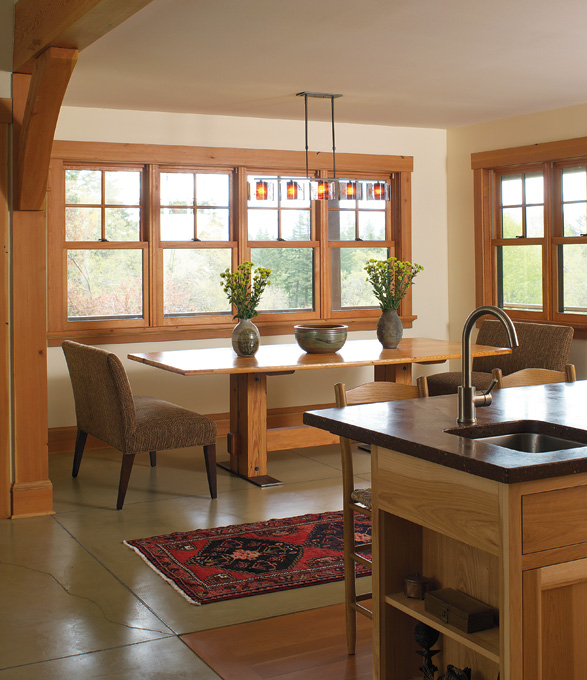{artsexylightbox}{/artsexylightbox}
Ilysa and Steve Parker, longtime Hood River residents and outdoor enthusiasts, wanted a home where they could easily get to town but that was just far enough away to feel removed. In 2005 they found a 5-acre parcel with a 1903 farmhouse, outbuildings, mature trees, a pond and Phelps Creek running through it. “You don’t see any other houses from here,” says Steve, a physician. “And you’re in town in just minutes.”
For the first three years, they did little with the property. “Friends rented the house,” says Ilysa, who works as a nurse. “We stayed in one of the picker’s cabins and cooked in an outdoor kitchen.” They planned to remodel the farmhouse, but its rubble foundation had failed. Instead, they deconstructed the house, salvaging material for their new home. “This was a great project for working with reclaimed and local materials,” says builder Steven Todorov of Green Home Construction in Hood River.
To design the house, the Parkers worked with Lake Oswego designer Paden Prichard. “We wanted a sustainable home,” says Ilysa. “We wanted it to be small but comfortable.” They meticulously planned the 2,300-square-foot home’s layout. “Ilysa measured rooms in other houses to see how small you could go,” says Steve. “She plotted on graph paper to decide how much space we needed.”
The two-bedroom, two-bath home, completed in 2010, opens onto a combined kitchen and living and dining area designed for entertaining on one side, with an office and guest suite on the other. The office bookcases cleverly conceal a full-sized trundle bed incorporated into the adjacent empty space below the open staircase to the master bedroom. “Kids love it,” says Steve. “They call it the Harry Potter bed.”
{besps}articles/2012/2012_AugSept/HoodRiver|width=680|height=500{/besps}
{besps_c}0|01.jpg|The home of Ilysa and Steve Parker nestled in the woods.|PHOTO STEVE TAGUE{/besps_c}
{besps_c}0|02.jpg|Ilysa and Steve Parker on their screened porch.|PHOTO STEVE TAGUE{/besps_c}
{besps_c}0|03.jpg|Pottery on the dining table built by Steve Parker.|PHOTO STEVE TAGUE{/besps_c}
{besps_c}0|04.jpg|Colorful art and furniture grace the hallway. |PHOTO STEVE TAGUE{/besps_c}
{besps_c}0|05.jpg|Stained glass inset into a door.|PHOTO STEVE TAGUE{/besps_c}
{besps_c}0|06.jpg|Different materials and textures for the garage.|PHOTO STEVE TAGUE{/besps_c}
{besps_c}0|07.jpg|One of the old structures on the property.|PHOTO STEVE TAGUE{/besps_c}
{besps_c}0|08.jpg|Antique tools found on the property.|PHOTO STEVE TAGUE{/besps_c}
{besps_c}0|09.jpg|The covered porch is a place for relaxation.|PHOTO STEVE TAGUE{/besps_c}
{besps_c}0|10.jpg|The Parkers used natural materials and green building techniques for their home.|PHOTO STEVE TAGUE{/besps_c}
{besps_c}0|11.jpg|Floorplan for main floor.|{/besps_c}
{besps_c}0|12.jpg|Floorplan for top floor.|{/besps_c}
{besps_c}0|13.jpg|Wood warms the home.|PHOTO STEVE TAGUE{/besps_c}
{besps_c}0|14.jpg|Natural stone on the exterior.|PHOTO STEVE TAGUE{/besps_c}
{besps_c}0|15.jpg|Copper gutters.|PHOTO STEVE TAGUE{/besps_c}
{artsexylightbox}{/artsexylightbox}
The home’s location in the Columbia River Gorge National Scenic Area required a Columbia River Gorge Commission review of its plans and materials, such as the cedar exterior, basalt rock and recycled-tire roofing. “Even though our home can’t be seen, we still had to go through the process,” says Ilysa. “It added several weeks to the project while we waited for approval.”
The Parkers spend a lot of time outdoors, and the design of their home reflects that. “For us, home is for the end of the day,” says Ilysa. “We’d rather be out doing things.” A covered porch with screened windows off the living area creates an immediate outdoor connection. “I grew up in a house in Connecticut that had a screened porch,” says Steve. “You can enjoy the outdoors without worrying about the weather.” A large porch wraps around the back of the house, and a covered hot-tub deck forms part of the master suite.
During construction, they tried to preserve as many of the trees and bushes as possible. “We only had a maple that didn’t make it, and we replanted all the bushes,” says Ilysa. The Parkers also renovated the pole barn, a shed and a picker’s cabin, creating a property with a unified look. “When we tore down the farmhouse, we had to change our plans,” says Steve. “We reimagined what we could have here.”
Key green features
- The wood from the old house was milled on-site and reused in the stair landing and for interior window and door trims.
- Locally reclaimed and salvaged wood was used for the flooring on the second floor, the stairs and the timbers on the first floor.
- The stonework is locally quarried Columbia River basalt.
- Eco-friendly finishes, such as low-VOC paints and Osmo PolyX, a European food-grade hardwax oil, were used throughout the house.
- The ground floor has radiant heat supplied by a geothermal heating system that also heats the home’s water. A heat-recovery ventilation unit provides whole-house ventilation.
- The EcoSlate roof is made from 100 percent recycled tires.



